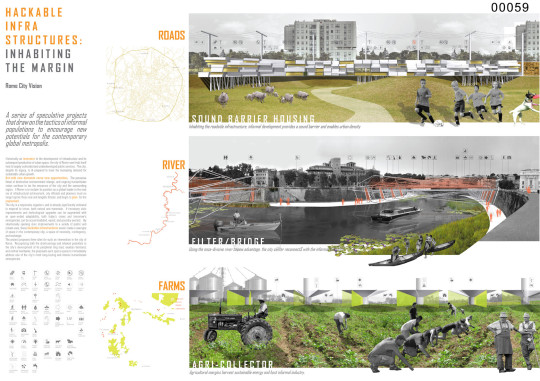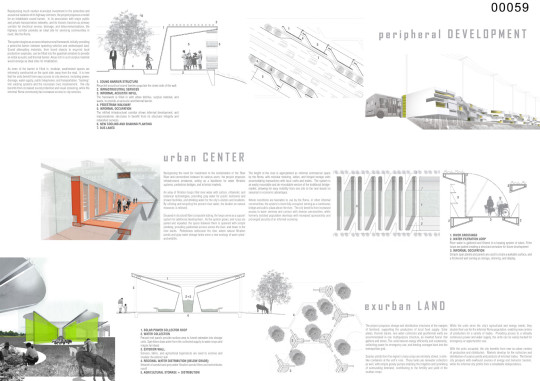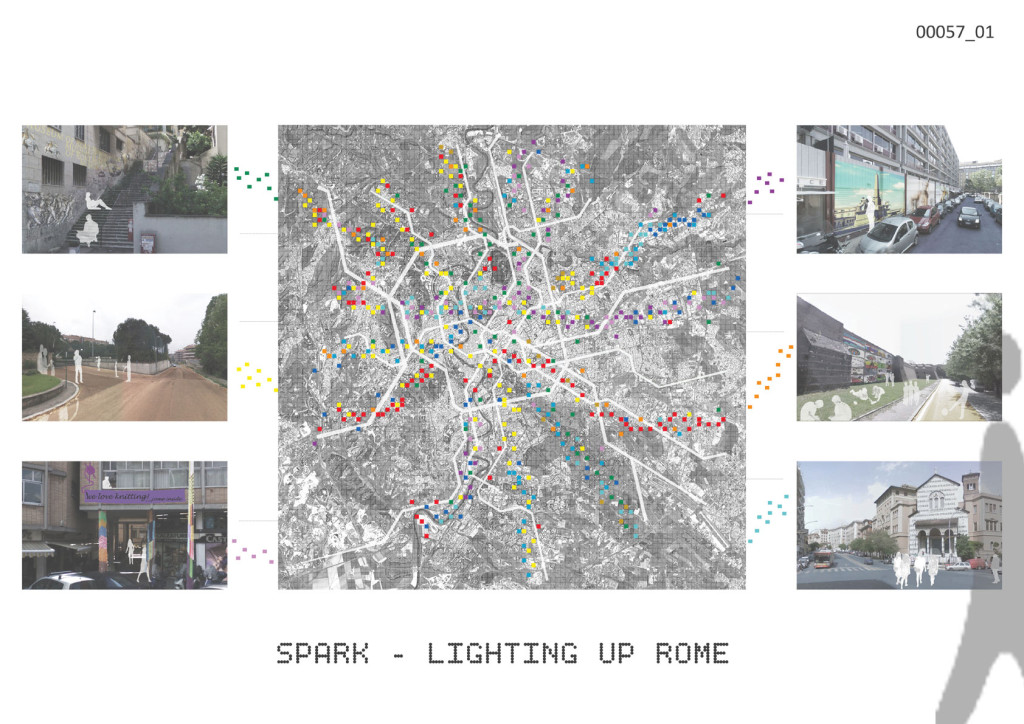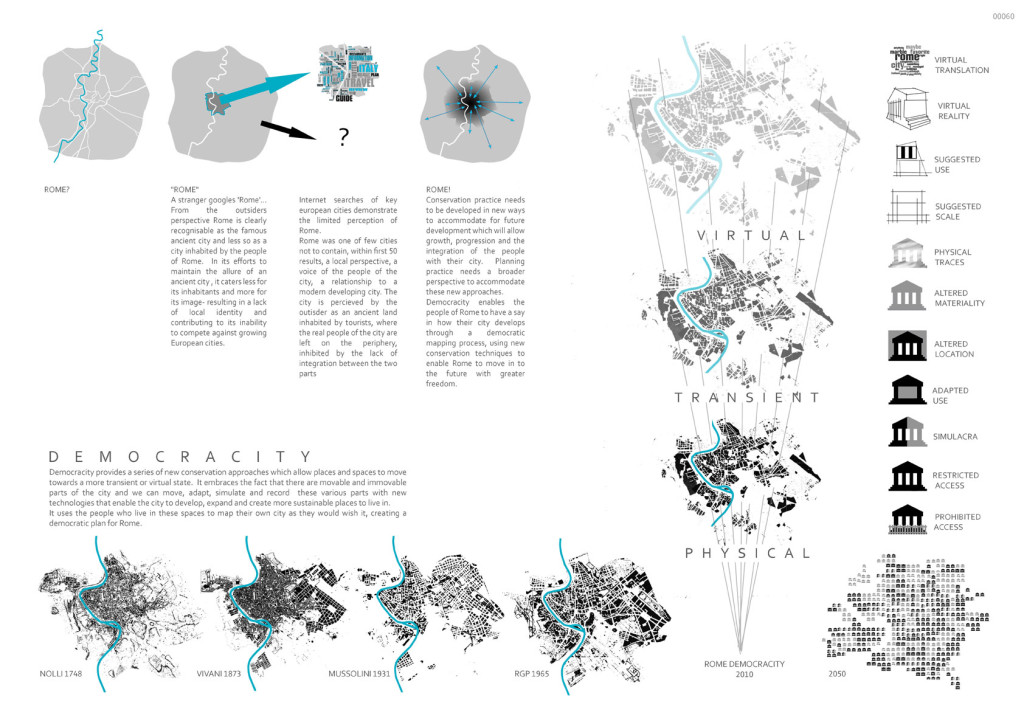Info:
Title: HACKABLE INFRA STRUCTURES - Code: 00059Contest: Rome / 2010
By: E. Kripa / S. Mueller
Views: 2795 Likes: 0
Votes:
JUERGEN MAYER H. 0 FRANCESCO LIPARI2 FELIPE ESCUDERO4 FRANCESCO GATTI 7 MICHAEL CATON 63.8
HACKABLE INFRA STRUCTURES


HACKABLE INFRASTRUCTURES
INHABITING THE MARGINS OF CONTEMPORARYROME
Historically an innovator in the development of infrastructure and its subsequent production of urban space, the city ofRome now finds itself host to largely outmoded and underdeveloped public services. The city, despite its legacy, is ill-prepared to meet the increasing demand for sustainable urban growth.
But with new demands come new opportunities. The pervasive threat of destructive environmental change, and ongoing humanitarian crises continue to tax the resources of the city and the surrounding region. If Rome is to reclaim its position as a global leader in the next era of infrastructural achievement, city officials and planners must no longer ignore these real and tangible threats, and begin to plan for the unplanned.
The city is a responsive organism, and is already significantly endowed to respond to crises, both natural and manmade. If necessary civic improvements and technological upgrades can be augmented with an open-ended adaptability, both today’s crises and tomorrow’s emergencies can be accommodated, eased, and possibly averted. By intentionally opening civic improvements to a variety of public and private uses, these hackable infrastructures would create a new type of space in the contemporary city: a space of necessity, contingency, and exchange.
The project proposes three sites for such an intervention in the city ofRome. Recognizing both the shortcomings and inherent potentials in the city’s development of its peripheral ring road, exurban farmland, and central riverbanks, the proposals each open a space to immediately address one of the city’s most long-lasting and intense humanitarian emergencies.
The Romani population inRomeis a community in constant crisis. Historically a nomadic, stateless people, the population has largely settled into a semi-permanent, but tenuous relationship with Italian society. Though a large percentage holds Italian citizenship, the Roma (gypsies) are ostracized, undermined, and discriminated against by officials and citizens alike. Once voluntarily transient, the Roma now find themselves reluctantly so, displaced by forced evictions, arson, and acts of violence that have escalated in recent years. Though the average Roman citizen is far more mobile socially, economically, and physically than the average Romani, the “constant movement” of the Roma is seen as a threat to stability throughout metropolitanRome.
Three project proposals envision infrastructural and architectural frameworks that enable the preservation and co-habitation of Roma and Roman culture. Providing a hackable infrastructure that enables both populations to adapt to the changing needs of the contemporary city, the projects redefine the role of the architect and city planner. Absolving designers of the burden to impose a uniform image of urbanity for populations that cannot fulfill its expectations, these tactical urbanisms allow instead for multiple images of the city to emerge-where the built environment is responsive and representative of the people it serves, and the global economy of which it is a part.
SOUND BARRIER HOUSING
As the city expands, its patterns of wasteful land use are self-perpetuating. The need for new residential, commercial, and business centers for a growing population is exacerbated by the challenges of finding available and desirable land. City officials have been working with a team of local and international architects, developing plans to revitalize areas on the outskirts. But their efforts are met with some difficulty, as development in these zones requires ever-greater amounts of land to be given over to the highways and service roads that would allow them easy access. These high speed traffic corridors create a visual and auditory nuisance, and a safety hazard that prohibits a sustainable level of urban density and development. Protective guardrails and acoustic barriers are vital to the success of future development.
In this peripheral environment, the municipal government has sponsored the construction of permanent Roma camps. Along the ring road and the radial highways, these communities are underserviced and inaccessible, all but abandoned by the city only a few months after their construction. With no regular maintenance, the few municipal services provided become inoperable, water pumps are broken and electrical service is spotty at best. Without immediate access to transportation, the residents of the camp are intentionally kept outside of the social and economic benefits of the city proper. After a few years on the margin, the living conditions of the camps irreparably devolve. The camps must tap into the services and transportation enjoyed by the rest of the city if they are to survive.
Repurposing much-needed municipal investment in the protection and acoustical isolation of its several highway corridors, the project proposes a model for an inhabitable sound barrier. In its association with major public and private transportation networks, and its historic function as primary corridor for electrical service, drainage, and telecommunications, the highway corridor provides an ideal site for servicing communities in need, like the Roma.
The system begins as an open infrastructural framework, providing a rigid guardrail and initial protective barrier between speeding vehicles and undeveloped land. Sound attenuating materials, from found objects, to municipal compost, to local production surpluses, can be fitted into the guardrail armature to provide an initial acoustic and thermal barrier. Areas rich in such surplus material would emerge as ideal sites for inhabitation.
As more of the barrier is filled in, modular, weatherized spaces are informally constructed on the quiet side, away from the road. It is here that the units benefit from easy access to city services, including power, drainage, water supply, public telephones, and transportation, “hacking” into existing systems and the necessary civic improvement. The city benefits from increased sound protection and visual screening, while the informal Roma community has increased access to city services.
FILTER / BRIDGE
The increasing density of the urban core is putting ever-greater pressures on the city’s ability to provide basic water services and safe passage for its residents and visitors. With the growing local population, and increased seasonal demands by tourists and visitors, the city’s water supply is in desperate need of an upgrade. Public facilities are few and far between, and potable drinking water is a luxury to be bottled and sold. The city’s great liquid asset, theTiberRiver, has dwindled in its civic importance, as its major crossings are choked with automobile traffic, its embankments barely noticed by casual visitors and citizens alike. Once a connective force for the landscape ofRome, the River is now highly divisive, slicing communities in disparate halves. The power of the river must once again be harnessed.
The river has proven itself an ideal site for informal inhabitation, service, and commerce. Roma camps fluidly navigate its meandering edge, using its banks as staging grounds for dwelling and informal economies. It is here that they enjoy some anonymity, hidden in plain sight at the heart of the city. Benefitting from proximity to schools, jobs, and the bustling citizens ofRome, the river camps provide unique opportunities for interchange. This delicate balance, however, is often upended. When camps too near the city center are discovered, or become too crowded, they are quickly disbanded by public officials, their residents forced to evacuate to more remote locales. A mode of responsible and secure interaction must be imagined.
Recognizing the need for investment in the revitalization of the TiberRiverand connections between its various users, the project proposes infrastructural armatures, acting as a backbone for water filtration systems, pedestrian bridges, and informal markets. An array of filtration loops filter river water with carbon, ultraviolet, and botanical technologies, providing gray water for public restrooms and shower facilities, and drinking water for the city’s visitors and residents. By utilizing and recycling the present river water, the burden on natural resources is relieved.
Composed of structural fiber composite tubing, the loops serve as a support system for additional development. As the system grows, and loops are paired and repeated, the space between them is spanned with simple planking, providing pedestrian access across the river, and down to the river banks. Users find a whole new way to navigate the city, from water level, where natural filtration ponds and gray-water storage tanks serve a new ecology of river plant- and wildlife.
The height of the loop is appropriated as informal commercial space by the Roma, with modular shelving, tables, and hinged storage units serving as display space for transactions with local crafts and trades. The system is an easily mountable and de-mountable version of the traditional bridge-market, allowing for easy mobility from one site to the next based on seasonal or economic advantages.
Where conditions are favorable to use by the Roma, or other informal communities, the system is more fully occupied, serving as a continuous bridge and public plaza above the river. The city benefits from increased access to water services and isolated communities, while formerly isolated population develop with increased sponsorship and prolonged security of an informal economy.
AGRI COLLECTOR
The city’s food supply is increasingly dependent on remote sources, while peripheral agricultural land lies underutilized and underproductive. Inefficient management of water resources, an aging rural population, and the lack of diversification of local crafts industry negatively affect rural agricultural production, to the detriment of the city’s sustainable growth. To maintain its current levels of consumption, and compete with the global metropolis of tomorrow, the city must advance its energy infrastructure, while ensuring the responsible development of its exurban periphery into more locally-networked centers of agricultural production.
The Roma are similarly dependent on external chains of production and distribution, their livelihoods and very survival often dependent on economic processes beyond their control. With a history of reluctant dependence on the formal city and its citizens for food and energy, the Roma are often cast in a negative light. In order to flourish on their own terms, the Roma must chart a path to increasing self-sufficiency.
The project proposes storage and distribution structures at the margins of farmland, supporting the production and distribution of local food supply. Solar plates, thermal stacks, rain water collectors and geothermal wells are accommodated in one multipurpose structure, an inverted funnel that gathers and stores. The units harvest energy efficiently and sustainably, collecting power for emergency use, and feeding overages back into the metropolitan grid.
Surplus yields from the region’s many crops are similarly stored, in silo-like containers at the unit’s core. These tanks are rainwater collectors as well, with simple gravity pumps enabling the irrigation and sprinkling of surrounding farmland, contributing to the fertility and yield of the exurban crops.
While the units serve the city’s agricultural and energy needs, they double their use for the informal Roma population, enabling new centers of production for a variety of trades. Providing access to a virtually continuous power and water supply, the units can be easily hacked for emergency or opportunistic use. Local Roma traditions of metalsmithing and jewelry are given new life on the city’s edge, where communication between artisans from different communities catalyzes the rebirth of their trades.
With the units occupied, the city benefits from new ex-urban centers of production and distribution. Markets develop for the collection and distribution of surplus yields and products of informal trades. The formal city prospers with newfound sources of energy and domestic tourism, while the informal city profits from a remarkable independence.
Info:
Title: HACKABLE INFRA STRUCTURES
Time: 16 marzo 2010
Category: Rome
Views: 2795 Likes: 0
Tags: -






